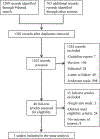Meta-analysis of Effect of Modest (≥10%) Weight Loss in Management of Overweight and Obese Patients With Atrial Fibrillation
- PMID: 31540665
- PMCID: PMC7089802
- DOI: 10.1016/j.amjcard.2019.08.009
Meta-analysis of Effect of Modest (≥10%) Weight Loss in Management of Overweight and Obese Patients With Atrial Fibrillation
Abstract
Obesity and atrial fibrillation (AF) are growing epidemics with significant overlap in co-morbidities. Multiple smaller studies have evaluated the effects of weight loss and risk factor modification on recurrence of AF, reduction in AF burden and improvement in AF symptom severity. The objective of this study was to determine if a modest weight loss of ≥10% of initial body weight is enough to improve outcomes in overweight or obese patients with established AF. We performed an extensive literature search and systematic review of studies that compared weight loss of ≥10% versus weight loss of less than 10% or weight gain and assessed outcomes including recurrence of AF as determined through a Holter monitor, AF burden and improvement in AF symptom severity. Risk ratio 95% confidence intervals (CI) were measured for dichotomous variables and mean difference (MD) 95% CI were measured for continuous variables, where MD >0 favors the group with ≥10% weight loss. Five studies with a total of 548 patients were included. Patients who lost ≥10% of their initial body weight experienced less recurrence of AF (risk ratio 0.29; 95% CI 0.19 to 0.44) and a larger reduction in reported event frequency (MD 1.74; 95% CI 0.70 to 2.79), episode duration (MD 2.14; 95% CI 0.04 to 4.23), global episode severity (MD 1.89; 95% CI 1.34 to 2.45), and symptom severity (MD 5.36; 95% CI 3.75 to 6.97). In conclusion, weight loss is associated with less risk of recurrent AF, reduction in AF burden, and improvement in AF symptom severity.
Copyright © 2019 Elsevier Inc. All rights reserved.
Figures





References
-
- Miyasaka Y, Barnes ME, Gersh BJ, Cha SS, Bailey KR, Abhayaratna WP, Seward JB, Tsang TS. Secular trends in incidence of atrial fibrillation in Olmsted County, Minnesota, 1980 to 2000, and implications on the projections for future prevalence. Circulation 2006;114:119–125. - PubMed
-
- Chugh SS, Havmoeller R, Narayanan K, Singh D, Rienstra M, Benjamin EJ, Gillum RF, Kim YH, McAnulty JH Jr., Zheng ZJ, Forouzanfar MH, Naghavi M, Mensah GA, Ezzati M, Murray CJ. Worldwide epidemiology of atrial fibrillation: a Global Burden of Disease 2010 Study. Circulation 2014;129:837–847. - PMC - PubMed
-
- Flegal KM, Carroll MD, Kit BK, Ogden CL. Prevalence of obesity and trends in the distribution of body mass index among US adults, 1999–2010. JAMA 2012;307:491–497. - PubMed
-
- Wang TJ, Parise H, Levy D, D’Agostino RB Sr., Wolf PA, Vasan RS, Benjamin EJ. Obesity and the risk of new-onset atrial fibrillation. JAMA 2004;292:2471–2477. - PubMed

